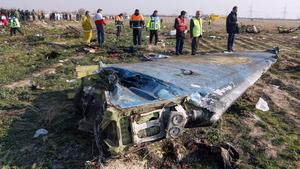 In this file photo, rescue teams are seen at the scene of a Ukrainian airliner that crashed shortly after take-off near Imam Khomeini airport in the Iranian capital Tehran. (PHOTO / AFP)
In this file photo, rescue teams are seen at the scene of a Ukrainian airliner that crashed shortly after take-off near Imam Khomeini airport in the Iranian capital Tehran. (PHOTO / AFP)
PARIS - Investigators have begun work on the flight recorders from the Ukrainian airliner accidentally shot down by Iran in January, France’s BEA accident investigation bureau said on Monday.
Ukrainian President Volodymyr Zelenskiy on Monday said he welcomed Iran’s decision to hand over the black boxes to France, saying those responsible would be held accountable
Iranian forces say they downed the Ukraine International Airlines (UIA) jet, a Boeing 737, on Jan 8 after mistaking it for a missile at a time of high tensions with the United States. All 176 people aboard Flight PS752 were killed.
Lab work to extract data from the black boxes got underway after a preliminary meeting with Iranian and other officials present at BEA headquarters outside Paris, a spokesman said.
READ MORE: Iran says human error led to downing of Ukrainian airliner
The cockpit voice recorder will be accessed first, with the flight data recorder to follow, he said, adding that the work was likely to take at least until Thursday.
The data extraction is also being observed by Canadian, US, Swedish and British air accident investigators as well as representatives from UIA, Boeing and engine maker Safran.
Iran agreed in June to send the black boxes to the BEA for analysis, ending a long standoff with Canada, Ukraine and France over access to the data.
Many of the crash victims were Canadian citizens or permanent residents, or had Canada as their final destination.
ALSO READ: France confirms it will read black boxes of downed Ukrainian jet
Ukrainian President Volodymyr Zelenskiy on Monday said he welcomed Iran’s decision to hand over the black boxes to France, saying those responsible would be held accountable.
He added that Ukrainian experts would take part in decoding the black boxes.
An interim report by Iran’s Civil Aviation Organisation last week blamed a misalignment of a radar system and lack of communication between the air defense operator and his commanders for the tragedy.


